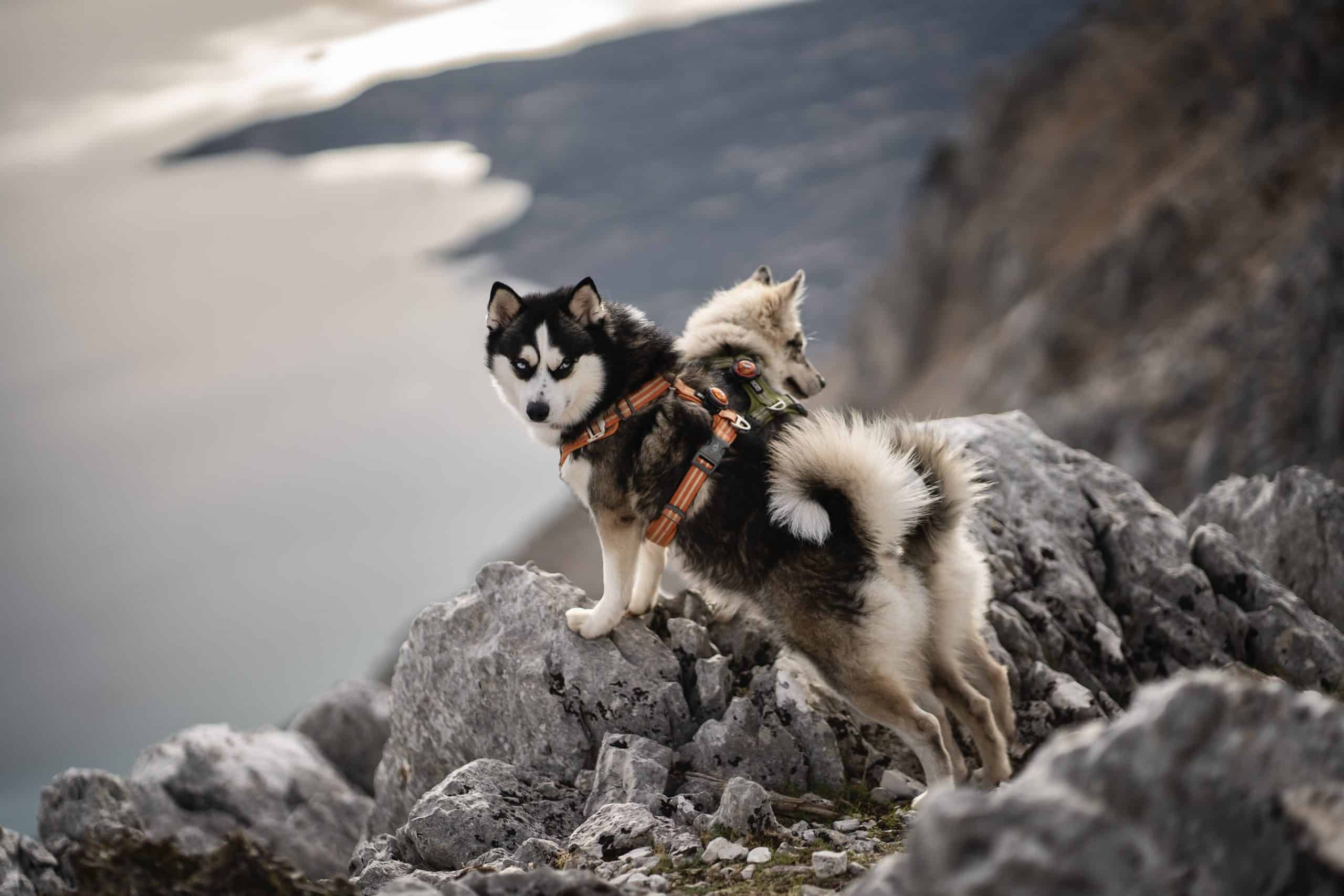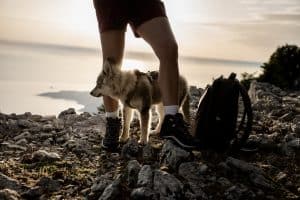As a dog owner who loves hiking, bringing your furry friend along can make a big positive difference in your outdoor adventure. However, taking your dog hiking requires preparation and care. To ensure that you and your four-legged companion have a successful hike, consider these tips:
– Pre-hike preparations: Before heading out on a hike, consult your vet to ensure that your dog is up to date with vaccinations. Read up on obedience training and trail etiquette, and choose appropriate trails that match your dog’s skill level. To avoid injuries, it is important to build up your dog’s stamina gradually.
– Gear: Pack essentials for both you and your dog. Bring enough food and water for both of you and consider bringing a water filtration system if you plan to hike for a longer Other essentials for your dog may include a collapsible water bowl, dog boots and a first aid kit.
– Food and water planning: On hikes, your dog will need more fuel and may even carry some of it. Be mindful of your dog’s water intake and bring enough water for the entire trip.
– Beware of trail hazards: Consider water safety and beware of potential hazards on the trail such as heat, creatures, plants and other health risks. Familiarise yourself with the area’s wildlife and be prepared to handle any situation that may arise.
Preparing your dog for the trailIt is important to gradually ease your dog into the routine of hiking. Start with shorter hikes and gradually increase the distance and duration as your dog builds stamina. This also helps to toughen its paw pads. Moreover, it is also important to train your dog to be comfortable with being carried. Carrying your dog is necessary when it gets tired or injured, or when the trail gets too rough for it to handle. Here are some tips on how to train your dog to be carried while hiking: – Start slow: Begin by introducing your dog to being carried in a comfortable and safe environment, e.g. in an indoor space using a dog carrier or sling. Gradually increase the duration of carrying and the level of activity. – Reward positive behaviour: Reward your dog with treats and praise when it shows positive behaviour, such as being calm and relaxed during the training sessions. This will nudge it to associate being carried with positive experiences. – Practise on short hikes: Once your dog is comfortable being carried indoors, take it on short hikes and gradually increase the distance. Start with flat and easy terrain and slowly move onto more challenging trails. – Choose the right carrier: Make sure to choose the right carrier based on what is comfortable for both you and your dog. The carrier should be sturdy and secure, and it should fit your dog properly. Training your dog to be carried while hiking can be a fun and rewarding experience for both you and your furry friend. |
 |
Be considerate on the trail
Before heading out for a hike with your furry friend, it is essential to beware of leash laws in the area you plan to visit. Leash laws vary from country to country, from area to area and even from one trail to another, so it is important to do your research in advance. Furthermore, always check if dogs are allowed on the trail and comply with any restrictions. Remember to keep your dog under control at all times – particularly around other hikers and animals.
When hiking with your dog, it is important to be considerate of other hikers and their pets. Not everyone may feel comfortable around dogs, so it’s crucial to keep your furry friend under control at all times. Even if other dogs appear friendly, it’s better to be safe than sorry and maintain control of your dog. Also, when meeting hikers, horses or bicycles on the trail, be sure to step off the path and allow them to pass. Having your dog on a leash is a good start, but it’s also important to be able to keep it calm in the presence of others.
 |
|
What to pack?
If you’re planning on hiking with your furry friend, it’s important to pack the right gear to keep it safe, comfortable and hydrated. Below is a list of essential items to bring when hiking with your dog:
 |
– Dog pack: Choose a pack that fits your dog comfortably and distributes weight evenly. It’s important to note that puppies should not carry a load until its immune system is fully developed. To train your dog to wear a backpack, choose a properly fitted one and introduce it gradually. Start with an empty backpack on your everyday walks, and then gradually add weight. Monitor your dog while going on everyday walks to ensure that it is comfortable and take breaks as needed. – First-aid kit: Bring a dog-specific first aid kit and learn how to use it in case of an emergency. Here are some essential items to include in your dog’s hiking first aid kit: antiseptic wipes and ointment, gauze pads and bandages, tick remover tool, tweezers, scissors, saline solution, thermometer, muzzle and emergency contact information. – Sleeping system: Make sure your tent is large enough to accommodate you and your dog. A closed-cell foam pad and crib-size comforter make a cosy and lightweight bed. Practise backyard sleepouts beforehand to ensure your dog is comfortable. – Water container: Fresh water is essential for your dog’s hydration. Use a bottle or collapsible dish, whichever your dog is used to drinking from. Remember to bring enough water for your dog and take frequent breaks to prevent overexertion. |
– Booties: Protect your dog’s paws from sharp rocks, thorns and snow. Bring spares in case they get lost and allow time for your dog to get used to wearing them.
– Dog towel: A dedicated “hiker towel” can help wipe off muddy paws before entering the tent. Bring an extra towel to dry your dog if it gets wet.
– Claw clippers and file: Trim your dog’s claws before hitting the trail to prevent damage to tent fabric.
– Safety Light: Keep track of your dog after sunset and during nighttime potty breaks with a safety light.
– Dog coat: If your dog has thin fur or if temperatures will be low, bring a coat to keep it
– Cooling gear: Dogs struggle to regulate their body temperature in hot weather, so a cooling accessory can help prevent heat exhaustion.
– Dog waste bags: Additionally, it’s important to practise “Leave no trace” ethics while hiking with your dog. This includes picking up and properly disposing of your dog’s waste, as it can contain harmful bacteria and pollutants. On backpacking trips, both humans and dogs should follow the same rule and avoid urinating and defecating near water sources.
By packing these essentials, you and your dog can enjoy a safe and comfortable hike together.
Planning food and water for your dog on hiking trips
|
When you’re taking your furry friend on a hiking trip, it’s important to pack plenty of food and water. Your dog will require more water and calories than it usually consumes during the course of a day, so keep that in mind when packing. As a general rule, dogs should drink between 50 ml and 100 ml of water per kilogram of body weight per day. If your dog weighs e.g. 10 kg, it should drink between 500 ml and 1 l a day. However, these are just guidelines, and you should offer your dog water regularly – especially on hot days. If your dog’s nose is dry, it’s a sign that it needs more hydration. No matter what hike you choose, your dog will require more food than usual. Steep or lengthy trails require even more calories, just like they do for humans. If your dog tends to stray far from you, you’ll need to increase its calorie intake even more. If you’re planning a trip for several days or a thru-hike, it’s best to check with your dog’s veterinarian for specific food recommendations. It’s important to keep in mind that dogs can experience tiredness, hunger and thirst just like humans do. However, not all dogs display clear indications of these needs, and their enthusiasm can sometimes mask their actual needs. To ensure your dog’s well-being, it’s essential to take regular breaks and provide it with adequate water and food. |
 |
Here are some common signs to look for and how to address them:
– Fatigue: If your dog is slowing down, lagging behind or lying down frequently, it may be tired. It’s important to take frequent breaks and offer water to prevent overheating. If your dog is still tired after resting, it may be time to end the hike.
– Thirst: If your dog is panting excessively or licking its lips frequently, it may be thirsty. Always bring plenty of water and offer it to your dog regularly. If your dog is still thirsty after drinking water, it could be a sign of an underlying health issue – consult your vet to get it checked.
– Hunger: If your dog is sniffing around for food, licking its lips or begging for treats, it may be hungry. Bring along some treats or snacks for your dog, but be sure not to overfeed it. Overeating can lead to stomach upset and discomfort.
– Overheating: If your dog is panting heavily, has a rapid heart rate or is drooling excessively, it may be overheated. Find a shaded area and offer water immediately. If your dog’s condition doesn’t improve, it may be time to end the hike and seek veterinary attention.
By paying attention to your dog’s behaviour and needs on the trail, you can ensure that it has a safe and enjoyable hiking experience.
Make sure to take breaks together to eat, drink and catch your breath.
 |
Trail hazardsHiking with your furry friend can be a fun and exciting adventure, but it’s important to beware of potential hazards that can harm your dog. As dogs cannot communicate when something is wrong, it’s essential to be vigilant of the following dangers: – Overexertion: Keep an eye on your dog’s breathing and heart rate during breaks. If it takes too long to normalize, take more frequent breaks or shorten your hike. Limping is another indication that it’s time to call it a day. – Ticks: Check your dog thoroughly for ticks and remove any you may find after the hike. – Wild plants: Stop your dog from chewing on any poisonous or tainted plants to avoid digestive problems. Watch out for nettles, poison oak, ivy and sumac, as they can cause discomfort for both you and your dog. Thorns and burrs can be irritating, but foxtails are a more serious concern. These barbed seedpods can attach to your dog’s fur and enter sensitive areas, leading to serious complications or, in severe cases, even Avoid areas with grasses that have foxtails, and remove them with tweezers immediately if you notice excessive sneezing, head shaking, eye discharge or an abscess. – Heatstroke: Dogs can only cool off through panting and sweating through their pads. Make sure to rest often and provide water to avoid heatstroke. Consider using a cooling collar if your dog keeps lying down in shady areas. Moreover, when going to the trailhead, keep in mind that you should never leave your dog in a closed vehicle. Even on cool days, temperatures inside a vehicle can quickly rise. – Waterborne pathogens: Dogs are just as susceptible to waterborne pathogens as humans. Therefore, your safest choice is to bring water for both you and your dog and prevent your dog from drinking from e.g. lakes and streams. – Water safety: If your dog cannot swim, pack a dog PFD (personal flotation device). Avoid letting even a good swimmer cross a whitewater section of a creek, and carry it Be cautious when allowing your dog to swim in a lake, as its wet fur can lead to chills in cool temperatures. Make sure to towel your dog dry before bedtime. Stay safe out there! |
Share this: #orbiloc #orbilocsafetylight
 English
English Deutsch
Deutsch Dansk
Dansk
